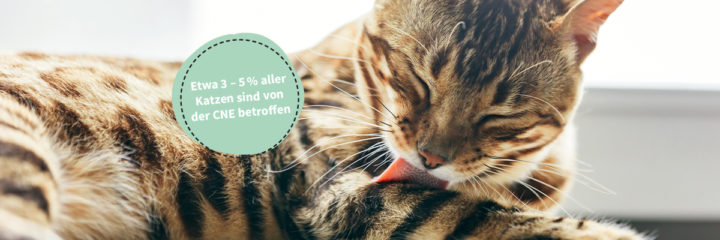
A brief overview
Approximately 3–5% of cats are affected by chronic kidney disease. The incidence increases with age, so by 12 years of age 50% of cats suffer from CKD. The disease is incurable, and its course is progressive. It is normally impossible to identify the factors triggering CKD. One thing they all have in common, however, is that they lead to loss of nephronsNephrone sind die Filtereinheiten der Nieren..... Nephrons are the filtration units of the kidneys. They perform a variety of tasks: excretion of toxins, control of body water and electrolyte balance, formation of hormone-like substances, and regulation of blood pH.
Diseases that can lead to CKD include those listed below.
- Inflammation of the kidneys and renal pelvis,
- The viral disease feline infectious peritonitis (FIP),
- Kidney tumours,
- Other disorders of the kidney and its function (“nephropathies” such as those caused by kidney calcification),
- Feline polycystic kidney disease,
- HypertensionHigh blood pressure.,
- Coagulation disorders,
- SclerosisThe hardening of an organ or tissue caused by a replacement of normal tissue with connective tissue. Sclerotic tissues and organs are less elastic.... (alterations of connective tissue) of the kidney,
- Kidney stones
- Urinary stasis of the kidneys (manifested as hydronephrosis).
Diagnosis by means of clinical symptoms and laboratory tests
The disease is diagnosed on the basis of clinical symptoms : anorexiaLoss of appetite, aversion to eating, in veterinary medicine also referred to as inappetence...., excessive urination (polyuriaExcessive production of urine, potentially due to kidney failure.... (PU)), severe thirst (polydipsiaExcessive thirst due to illness, leading to excessive production of urine (polyuria).... (PD)), drowsiness, weight loss, vomiting, dehydrationA deficit of total body water. Dehydration can be caused by excessive fluid loss, for instance via the kidneys in CKD, or by insufficient fluid intake.... and abnormal laboratory test results. Blood tests reveal azotaemiaIncreased levels of nitrogen-containing breakdown products of protein metabolism in the blood...., an increase in ureaUrea is the nitrogen-containing breakdown product of protein metabolism. The nitrogen from the proteins is converted to ammonia in the liver, which is combined with carbon dioxide to form urea. This is continuously excreted via the kidneys but also via sweat. Urea is one of... and creatinineCreatinine is a breakdown product of muscle metabolism. Its blood level is dependent, among many factors, on age, weight, nutritional status and muscle mass. Hence, creatinine levels in the blood vary from individual to individual. Creatinine is continuously excreted in the urine. Increased blood creatinine... in the blood. SDMASDMA = Symmetrical Dimethylarginine, which is a degradation product of the amino acid arginine and is excreted solely through the kidneys. SDMA is a highly specific biomarker for kidney function in cats. Read more: SDMA test (blood test)... levels in the blood are also elevated, as is phosphate (hyperphosphataemiaIncreased phosphate in the blood.). At the time of first diagnosis analysis still reveals a low specific gravity of the urine and potentially increased protein in the urine (proteinuriaIncreased protein in urine, leading to loss of protein. Normally, only a very small amount of protein is excreted in the urine. In chronic kidney disease, the amount lost may increase. High blood pressure damages blood vessels in the nephrons making them more permeable and...). The cats often also exhibit high blood pressure (hypertension). Further clinical symptoms and complications emerge in later stages due to raised levels of toxins in the blood such as urea (uraemiaA raised level in the blood of urea and other urinary substances, which in chronic kidney disease can no longer be adequately excreted due to impaired renal function (glomerular filtration rate). This leads to renal damage due to uraemic toxins, toxic urinary substances The symptoms...), because the kidneys can no longer fulfil their role in removing these uraemic toxinsToxic, nitrogen-containing urinary substances responsible for uraemia and kidney damage..... These complications : irritation of the stomach lining, ulcers of the mouth and stomach lining, bad breath, pancreatitis, anaemia, pneumonia, muscle twitching, compromised immune system, inflammation of the pleurae of the lungs and the peritoneum, heart muscle diseases, and comatose conditions.
A major problem for diagnosis is that, in most cases, there are no abnormalities in laboratory kidney test results until 75% of the nephrons of both kidneys have become non-functional.
Chronic kidney disease progression is unstoppable
CKD has a chronic but progressive course, meaning that the disease progressively worsens. This is down to the vicious circles that drive the disease. Cat kidneys contain approximately 200,000 filtration units (nephrons), which are not all used at the same time. “spare” nephrons exist, which are only used when existing filtration units cease to function. Over the course of life, the number of these “spare” nephrons decreases, and, in the end, no more nephrons can be replaced. However, the filtration rate of the existing nephrons can rise. Nephrons with such a raised filtration rate it for long. They also succumb, resulting in ever fewer functional nephrons.
When the number of active nephrons decreases, total kidney function drops. As the kidneys play a role in a variety of physiological processes, CKD cats suffer from a wide range of significant impairments and complications. The kidneys can be compared to sewage treatment plants; they remove metabolic breakdown products and toxins. The process goes hand in hand with control of water volume in the body; this involves elimination of excess water or its retention. If kidney function declines, too much phosphate remains in the blood (hyperphosphataemia), which, via fine regulation of the calcium-phosphate balance, leads to considerable complications mediated by the actions of parathyroid hormoneParathyroid hormone (PTH) is a hormone secreted by the parathyroid glands, which regulates calcium levels in the blood. PTH is secreted in response to low blood calcium levels (hypocalcaemia). An increase in calcium concentration above the normal value inhibits PTH production (negative feedback). PTH stimulates... and, ultimately, further nephron loss and accelerated progression of CKD.
Uraemic toxins, the breakdown products of protein metabolism, also accelerate CKD when they can no longer be sufficiently excreted. These are natural products of protein breakdown. Nevertheless, they are toxic to the kidneys, directly damaging them and leading to nephron loss and, thus, CKD progression. When they accumulate in the blood, known as uraemia, they are accompanied by clinical symptoms.
Last but not least, elevated blood pressure and the associated loss of protein (proteinuria) via the kidneys can further accelerate the disease. High blood pressure causes the pores of the blood vessels to enlarge, allowing larger molecules such as proteins to pass through into the urine. These cannot be recovered. Eventually, high blood pressure also injures the filtration units, leading to their destruction and, thus, to progression of the disease.
Staging – the four IRIS stages of CKD
Diagnosis and subsequent classification into one of the four stages is based on the guidelines of the International Renal Interest Society (IRIS), which also provides therapy recommendations for each stage. Staging= Classification of the cat into a stage of chronic kidney disease according to IRIS... is based on three factors.
- Degree of azotaemia, measured by the creatinine blood level
- Presence and degree of proteinuria
- Presence and degree of hypertension
Staging is performed only after confirmation of a diagnosis. It is important to note that a cat can be re-assigned to a more favourable stage if treatment is successful (the ideal case).
CKD usually progresses slowly, but, despite carefully managed treatment, spontaneous decline may occur suddenly and unexpectedly, with cats experiencing a significantly reduction in their general state of health. The kidney laboratory values can also deteriorate suddenly in such a phase. Veterinary treatment, such as infusions, can help a cat get back on its feet and also lower or stabilise kidney laboratory values. The fact that such acute decline cannot be predicted in advance is problematic. If a cat is responding well to its CKD treatment and has been stable over a long period of time, some cat owners may come to believe that the cat has recovered and their current condition will persist, and potentially give up on the many measures for treatment. Unfortunately, CKD is neither curable nor can it be stopped. Correct treatment can prolong the life of CKD cats and improve their quality of life.
Basics of CKD treatment
Once a cat has been diagnosed with CKD, the main focus of treatment is on prolonging life (slowing progression) and improving the cat’s quality of life. In addition to treating specific clinical symptoms, the four vicious circles mentioned above must be addressed. There are two ways to reduce phosphate, both of which are related to diet. Firstly, the cat can be fed kidney-friendly food, which contains less protein and therefore less phosphate (meat contains a lot of phosphate). Secondly, the cat can potentially be administered a phosphate binder mixed in with its regular food or later with its kidney-friendly food, which absorbs phosphate from the food in the intestines and causes it to be eliminated it in the faeces. As a result, the cat absorbs less phosphate and the burden on the kidneys is reduced. According to IRIS guidelines, phosphate in the blood needs to be strictly controlled and, dependent on disease stage, maintained at a certain level. As kidney function decreases over the course of the disease, combining both measures to lower phosphate levels is also an option.
Reducing Uraemic Toxins
Reducing uraemic toxin levels involves feeding with low-protein, kidney-friendly food. However, there are limits to this approach; cats are obligatory carnivores and dependent on a high protein content in their food. If their food contains too little protein, they will start to consume their own muscles and lose strength and weight. Both are important for cats with kidney disease. Nowadays, it is possible to remove these uraemic toxins as precursors from ingested food and eliminate them harmlessly in the faeces. This relieves the kidneys, as they will then have to excrete less toxins. At the same time, the damage done by such toxins to the kidney will be reduced, and the kidneys will be better able to control uraemia, decreasing its associated clinical symptoms. Uraemic toxin binders are equivalent to dialysis, administered via the diet. Both kidney-friendly food and “oral dialysis” can be combined.
High blood pressure is controlled by suitable medication. By reducing blood pressure, protein loss via the urine (proteinuria) can also be reduced, as high blood pressure leads to more protein passing out into the urine.
Water Intake Management
There are now a large number of treatment options that can be individually adapted. Besides slowing down the four vicious circles, it is also important to control your cat’s fluid balance. CKD cats lose increasing volumes of water via their kidneys, and, although they drink a lot, they are unable to retain the water in their it is immediately lost once again in the urine. Despite drinking a lot, they become dehydrated. The damaged kidneys can no longer recover the same quantity of water that healthy kidneys can.
Proper treatment can significantly prolong a cat’s life. This is dependent on early detection of kidney disease. It is now possible to diagnose a cat with chronic kidney disease earlier, for instance with the SDMA test. Owners with cats over seven years of age should consider having their kidneys checked annually for early identification of CKD.
Bibliography
- Schmidt, V. / Hozinek, M.C. (2005): Krankheiten der Katze [Diseases of the cat], pub.: Lutz, H. / Kohn, B. / Forterre, F., 5th fully revised and extended edition, Enke Verlag, Stuttgart.
- Chronische Nierenerkrankung der Katze [Chronic kidney disease of the cat]: vetion.de; https://www.vetion.de/focus/pages/index.cfm?focus_id=96
- Die chronische Nierenerkrankung der Katze: Stadieneinteilung und Behandlung anhand der Richtlinien der International Renal Interest Society [Chronic kidney disease of the cat: Staging and treatment in accordance with the guidelines of the International Renal Interest Society]: https://vetline.de/CKD-iris-behandlungsempfehlungen/150/2819/69432
- Staging CKD: http://www.iris-kidney.com/pdf/IRIS_2017_Staging_of_CKD_09May18.pdf
- Chronische Nierenerkrankung (CNE) der Katze [Chronic kidney disease (CKD) of the cat]: https://www.vetion.de/focus/pages/index.cfm?focus_id=96
- Little, S. / Kornya, M. (2015): Chronic Kidney Disease: https://www.winnfelinefoundation.org/docs/default-source/cat-health-libraryeducational-articles/chronic-kidney-disease-2015.pdf?sfvrsn=0
- Hintergrundinformation Niereninsuffizienz bei Hund und Katze [Background information on kidney failure in dogs and cats]: https://www.animal-health-online.de/klein/2010/10/19/hintergrundinformationenniereninsuffizienz-bei-hunden-und-katzen/6288/
- Durst ohne Ende -Ein häufiger Vorstellungsgrund für Haustiere in der Kleintierpraxis ist ein scheinbar unstillbarer Durst [Never-ending thirst – a common reason for presentation of pets in small animal practices is seemingly unquenchable thirst]: https://vetline.de/durst-ohne-ende/150/3586/80852/
- Das IRIS-System → eine aktuelle Hilfestellung zur effektiveren Therapie der CNI bei Hund und Katze [IRIS staging → an up-to-date aid for more effective therapy of CKD in dogs and cats]: https://vetline.de/iris-system-therapie-cni-hund-katze/150/3230/70652
- Demmel, A. (2011): Der Einfluss der alimentären Phosphorversorgung auf ausgewählte Nierenfunktionsparameter bei Katzen [The influence of dietary phosphorus supply on selected kidney function parameters in cats], dissertation, Faculty of Veterinary Medicine, LMU Munich: https://edoc.ub.uni-muenchen.de/13433/
- Phosphat als Kernproblem bei Katzen mit CNI [Phosphate as a core issue in cats with CKD]: https://vetline.de/phosphat-als-kernproblem-bei-katzen-mit-cni/150/3252/67496/
- King, J.N. / Tasker, S. / Gunn-Moore D.A. / Strehlau, G. and the BENRIC (benazepril in renal insufficiency in cats) study group: Prognostic Factors in Cats with Chronic Kidney Disease: https://onlinelibrary.wiley.com/doi/pdf/10.1111/j.1939-1676.2007.tb03042.x
- Chronic Kidney Disease (CKD) in Dogs & Cats – Staging and Management Strategies: https://www.vvma.org/Resources/Conferences/2015%20VVC/Speaker%20Proceedings/Chew-%20CKD%20notes.pdf
- Anti-Aging für Hund und Katze [Anti-ageing for dogs and cats]: synlab.de; https://www.synlab.de/fileadmin/user_upload/general/DE/veterinaer/vet_Tierhalterinfos/synlab-anti-aging-hund-katze.pdf
- Nierenerkrankungen – Diagnostik aus Blut und Harn [Kidney disease – blood and urine diagnostics]: http://v17.laboklin.de/pages/html/de/VetInfo/aktuell/lab_akt_0903.htm


